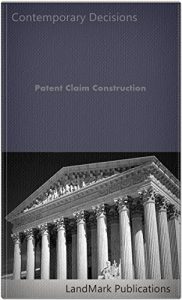THIS CASEBOOK contains a selection of 218 decisions of the U. S. Court of Appeals for the Federal Circuit that analyze and discuss issues surrounding patent claim construction. The selection of decisions spans from 2005 to the date of publication.
Claim construction begins with the words of the claim, which "must be read in view of the specification, of which they are a part." Phillips v. AWH Corp., 415 F.3d 1303, 1312-15 (Fed.Cir.2005) (en banc); Vitronics Corp. v. Conceptronic, Inc., 90 F.3d 1576, 1582 (Fed.Cir.1996). Although courts are permitted to consider extrinsic evidence, like expert testimony, such evidence is generally of less significance than the intrinsic record. Phillips, 415 F.3d at 1317 (citing C.R. Bard, Inc. v. U.S. Surgical Corp., 388 F.3d 858, 862 (Fed.Cir.2004)). Extrinsic evidence may not be used "to contradict claim meaning that is unambiguous in light of the intrinsic evidence." Id. at 1324. Wi-LAN, Inc. v. Apple, Inc., 811 F. 3d 455 (Fed. Cir. 2016).
Our claim construction analysis begins with the language of the claim itself, as it would have been understood by one of ordinary skill in the art at the time of the invention. Phillips v. AWH Corp., 415 F.3d 1303, 1312-13 (Fed.Cir.2005) (en banc). The claims "must be read in view of the specification, of which they are a part." Id. at 1315 (quoting Markman v. Westview Instruments, Inc., 52 F.3d 967, 979 (Fed.Cir.1995) (en banc)). Indeed, we have said that the specification "is always highly relevant p.1340 to the claim construction analysis. Usually, it is dispositive; it is the single best guide to the meaning of a disputed term." Vitronics Corp. v. Conceptronic, Inc., 90 F.3d 1576, 1582 (Fed.Cir.1996). Akzo Nobel Coatings, Inc. v. Dow Chemical Co., 811 F. 3d 1334 (Fed. Cir. 2016).
. . .
Claim construction begins with the words of the claim, which "must be read in view of the specification, of which they are a part." Phillips v. AWH Corp., 415 F.3d 1303, 1312-15 (Fed.Cir.2005) (en banc); Vitronics Corp. v. Conceptronic, Inc., 90 F.3d 1576, 1582 (Fed.Cir.1996). Although courts are permitted to consider extrinsic evidence, like expert testimony, such evidence is generally of less significance than the intrinsic record. Phillips, 415 F.3d at 1317 (citing C.R. Bard, Inc. v. U.S. Surgical Corp., 388 F.3d 858, 862 (Fed.Cir.2004)). Extrinsic evidence may not be used "to contradict claim meaning that is unambiguous in light of the intrinsic evidence." Id. at 1324. Wi-LAN, Inc. v. Apple, Inc., 811 F. 3d 455 (Fed. Cir. 2016).
Our claim construction analysis begins with the language of the claim itself, as it would have been understood by one of ordinary skill in the art at the time of the invention. Phillips v. AWH Corp., 415 F.3d 1303, 1312-13 (Fed.Cir.2005) (en banc). The claims "must be read in view of the specification, of which they are a part." Id. at 1315 (quoting Markman v. Westview Instruments, Inc., 52 F.3d 967, 979 (Fed.Cir.1995) (en banc)). Indeed, we have said that the specification "is always highly relevant p.1340 to the claim construction analysis. Usually, it is dispositive; it is the single best guide to the meaning of a disputed term." Vitronics Corp. v. Conceptronic, Inc., 90 F.3d 1576, 1582 (Fed.Cir.1996). Akzo Nobel Coatings, Inc. v. Dow Chemical Co., 811 F. 3d 1334 (Fed. Cir. 2016).
. . .



